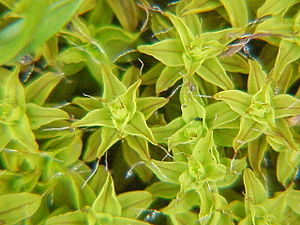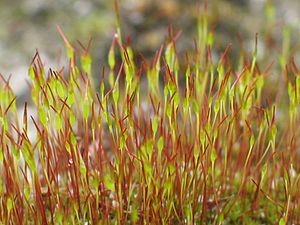Bryopsida
| Bryopsida | ||||||||||||
|---|---|---|---|---|---|---|---|---|---|---|---|---|

|
||||||||||||
| Systematics | ||||||||||||
|
||||||||||||
| Scientific name | ||||||||||||
| Bryopsida | ||||||||||||
| Pax |
The Bryopsida are a class of the deciduous moss (Bryophyta) and comprise around 98% of the deciduous moss species. They are also known as moss in the narrower sense .
Gametophyte
Protonema
In the life cycle of the moss, a richly branched greenish thread, the protonema, germinates from the haploid meio spores . At first it contains many chloroplasts and has transverse walls perpendicular to the thread, so that one speaks of a chloronema . This then goes into the low chloroplast Caulonema ( caulos = trunk). The caulonema has sloping transverse walls on the long side of the thread and forms buds from which the actual moss plant ( gametophyte ) grows.
Shoot and leaflet
All mosses are divided into shoots and leaflets ( phylloids ). However, the scion only has a support function and only takes on leadership functions in very few species. The mosses do not have roots either. They are simply anchored in the ground with multicellular rhizoids .
The leaflets consist of a single, more or less undifferentiated layer of cells. Often there is a midrib for stability. Although the moss grow with an apex cell that divides leaves on three sides, most moss have screw-like leaves, some species also have two rows.
Growth forms
When it comes to the habitus of the moss, a broad distinction is made between acrocarp (summit fruited) and pleurocarp (side fruited) moss.
The stems of the acrocarp moss are more or less upright and unbranched. They stand close together, which creates moss pillows. The sporophytes (capsules with stems) sit on the end of the stems or on the end of short main branches. The leaf cells of most acrocarpic mosses are rectangular, square or rounded. Such a leaf cell network is called parenchymal. A vein is almost always present in acrocarpic mosses.
The pleurocarpic mosses, on the other hand, form lawns of intertwined, branching and mostly more or less lying stems. The sporophytes usually sit on the sides of the branches or stems. In many pleurocarpic moss species, the cells of the leaves are extremely long and thin. In this case it is also said that the leaf cell network is prosenchymatic.
The pleurocarpy is a derived (developmentally young) characteristic, the acrocarpy as the original characteristic.
Gametangia
The sex organs ( gametangia ) are in deciduous mosses in groups at the ends of main shoots or small side shoots. They are often surrounded by specially designed bracts (= perichaetial leaves). Between the male gametangia ( antheridium ) and / or the female gametangia ( archegonium ) there may be sterile multicellular "sap hairs" (= paraphyses ). The male and female sexes of deciduous mosses can stand together in one shoot, but this is not always the case.
Sporophyte and capsule

The sporophyte is divided into three sections: the foot with which it is anchored in the gametophyte , the stalk ( seta ) and the capsule.
The foot serves as a haustorium and removes water and nutrients from the mother plant. The sporophyte is nutritionally not independent.
In the development of the spore capsule, an inner layer of cells ( endothecium ) and an outer layer ( amphithecium ) develop . The amphithecium forms the capsule wall, while the endothecium divides itself. The outer endothecium (effectively the middle layer) becomes the archespor (spore mother tissue), while the inner layers of the endothecium remain as a sterile column ( columella ). The columella is responsible for the water and nutrient supply of the spore mother tissue. The capsule is usually closed by a lid that falls off after ripening. This falling off of the lid is caused by a ring of swellable cells, the annulus .
Often, especially in the Bryidae , a tissue cap sits on the spore capsule, which still comes from the gametophyte and is known as calyptra .
After a while, the kalyptra falls off, releasing the peristome teeth , which in dry conditions open outwards and release the spores into the air.
Systematics
The Bryopsida are subdivided into eight subclasses, which include one to 13 orders. The classification of the Bryopsida has changed considerably since 2000 due to the increasing number of molecular genetic studies. The breakdown into subclasses and orders follows Stech and Frey 2009:
- Subclass Buxbaumiidae
- Order Buxbaumiales
- Subclass Diphysciidae
- Order Diphysciales
- Subclass Timmiidae
- Order Timmiales
- Subclass Encalyptidae
- Order Encalyptales
- Subclass Funariidae
- Order funariales
- Subclass Gigaspermidae
- Order gigaspermales
- Subclass Dicranidae
- Order Catoscopiales
- Order Scouleriales
- Order Bryoxiphiales
- Order grim
- Order Archidiales
- Order Mitteniales
- Order dicranales
- Order pottiales
- Subclass Bryidae
- order Hedwigiales
- Order Helicophyllales
- Order Bartramiales
- Order splachnales
- order bryales
- order Orthotrichales
- Order Orthodontial
- Order Aulacomniales
- Order Rhizogoniales
- Order Hypnodendrales
- Order Ptychomniales
- Order Hookeriales
- order Hypnales
For a breakdown down to the family level, see the moss system .
literature
- Jan-Peter Frahm , Wolfgang Frey : Moosflora (= UTB . 1250). 4th, revised and expanded edition. Ulmer, Stuttgart 2004, ISBN 3-8252-1250-5 .
- Jan-Peter Frahm: Biology of Mosses. Spectrum Akademischer Verlag, Heidelberg et al. 2001, ISBN 3-8274-0164-X .
Individual evidence
- ↑ Wolfgang Frey, Michael Stech, Eberhard Fischer: Bryophytes and Seedless Vascular Plants (= Syllabus of Plant Families. 3). 13th edition. Borntraeger, Berlin et al. 2009, ISBN 978-3-443-01063-8 , p. 146 ff.